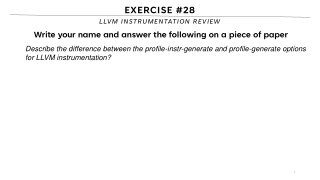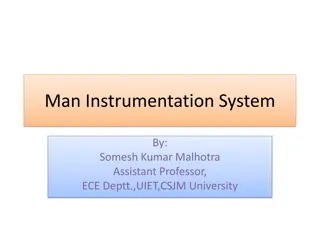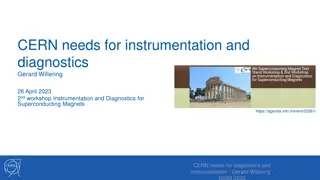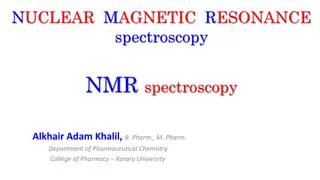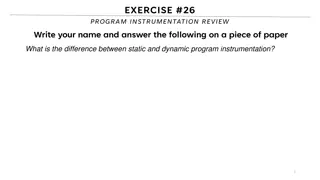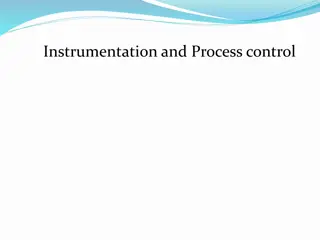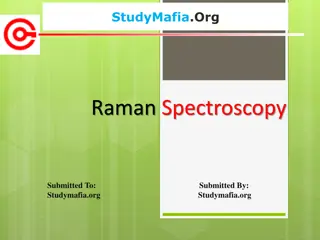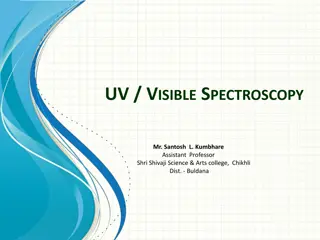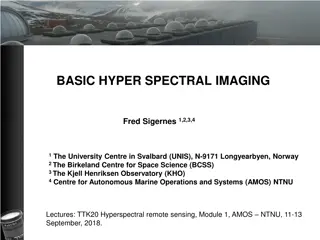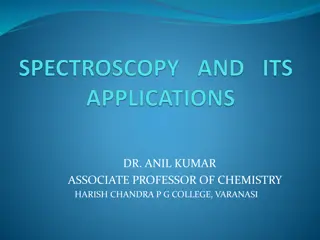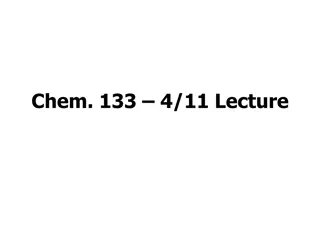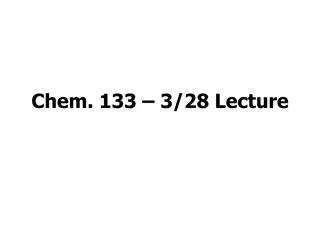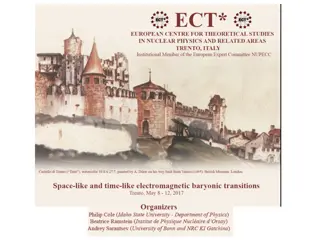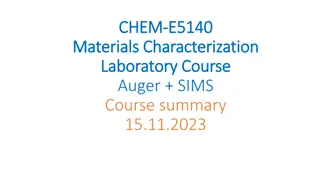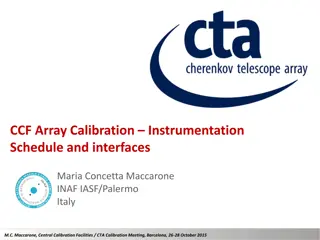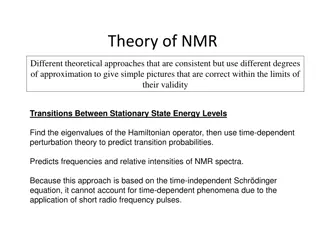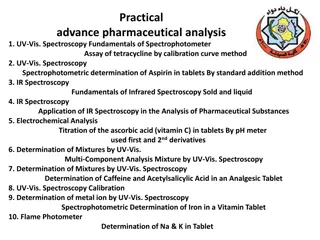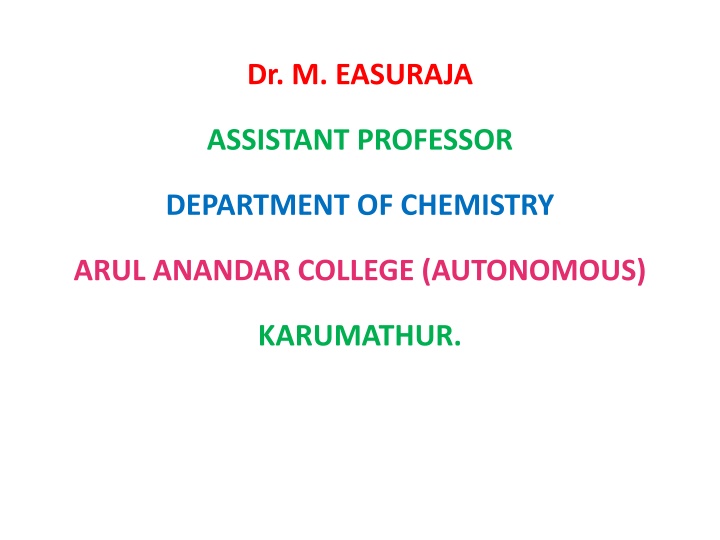
UV-Vis Spectroscopy and Its Applications in Chemistry
Explore the principles, types, and applications of UV-Vis spectroscopy in chemistry, detailing the interaction of light with matter to analyze electromagnetic spectra and electronic transitions. Learn about Woodward-Fieser Rules and the quantitative technique of spectrophotometry, essential for measuring light absorption in chemical substances.
Download Presentation

Please find below an Image/Link to download the presentation.
The content on the website is provided AS IS for your information and personal use only. It may not be sold, licensed, or shared on other websites without obtaining consent from the author. If you encounter any issues during the download, it is possible that the publisher has removed the file from their server.
You are allowed to download the files provided on this website for personal or commercial use, subject to the condition that they are used lawfully. All files are the property of their respective owners.
The content on the website is provided AS IS for your information and personal use only. It may not be sold, licensed, or shared on other websites without obtaining consent from the author.
E N D
Presentation Transcript
Dr. M. EASURAJA ASSISTANT PROFESSOR DEPARTMENT OF CHEMISTRY ARUL ANANDAR COLLEGE (AUTONOMOUS) KARUMATHUR.
Principle, Instrumentation and Applications of UV Spectroscopy
what is Spectroscopy? it is the study of the absorption and emission of light and other radiation by means of interaction with matter and to measures and interprets the electromagnetic spectra. Spectrum - image in Latin, Skopia - observation in Greek. study
Types: Molecular, Atomic, Electronic Ultraviolet-Visible (UV/Vis) Spectroscopy. Infrared (IR) Spectroscopy. Raman Spectroscopy. NMR Spectroscopy. H1 NMR, C13 NMR. Mass Spectroscopy
UV-Vis Spectroscopy (or Spectrophotometry) it is a quantitative technique used to measure how much a chemical substance absorbs light. This is done by measuring the intensity of light that passes through a sample with respect to the intensity of light through a reference sample or blank.
Radiation that has both electric and magnetic fields and travels in waves. It comes from natural and man-made sources. Electromagnetic radiation can vary in strength from low energy to high energy. It includes radio waves, microwaves, infrared light, visible light, ultraviolet light, x-rays, and gamma rays.
Principle involved When the interaction between incident radiation and the electron cloud in a chromophore results in an electronic transition involving the promotion of one or more of the outer shell or the bonding electrons from a ground state into a higher energy state, ultraviolet-visible ( UV-Vis) spectra are derived.
Woodward Fieser Rules (1941) * Acyclic Dienes * Sixmembered ring Dienes * unsaturated Dienes * Polyenes etc.
The acyclic diene base value may be *Homoannular *Heteroannular Base value are: S Cis S Trans 253 nm 215 nm
Exocyclic conjugated double bonds Add 5 nm in this case 10 nm
Alkyl substituents and ring residues Add 5 nm 3x5 = 15 nm 3x5 = 15 nm
Double bond Extending conjugation Add 30 nm 2x30 = 60 nm
Add 5 nm for Cl, Br 60 nm - NR2 30 nm - S alkyl 6 nm - O alkyl
Calculate the max max =
Base value = 253 Alkyl subs. 2x5 = 10 Ring resid. 3x5 = 15 Extending Con. 1= 30 Exocyclic 1 = 5 max = 313 nm
Base value = 253 Alkyl subs. 2x5 = 10 Ring resid. 3x5 = 15 Extending Con. 1= 30 Exocyclic 1 = 10 Exocyclic 2x5 = 10 max = 333 nm
Base value = 215 Ring resid. 2x5 = 10 Exocyclic 1 = 5 max = 230 nm
Base value = 253 Ring resid. 5x5 = 25 Extending Con. 2= 60 Exocyclic 1 = 5 max = 343 nm
, unsaturated ketones Base value Six membered ring = 215 nm Five membered ring = 202 nm Unsaturated aldehyde = 207nm Add 10 for each substituent on carbon 12 for carbon 18 for and carbon
Add 5 for Ring residue and alkyl substituents Extending Con. = 30 nm Exocyclic = 5 nm If auxochrome like OH present on the positions = 35 nm = 30 nm = 50 nm For OAc = 6 nm ( , , )
If OMe present on the positions Solvents Hexane Ether Dioxane Chloroform= + 1 nm Water = 35 nm = 30 nm = 17 nm = 31 nm = + 11 nm = +7 nm = +5 nm = - 8 nm
Base Value alkyl subst. 2x12 =215 nm = 24 nm max = 238 nm
Base Value alkyl subst. alkyl subst. 2x12 =215 nm = 10 nm = 24 nm max = 249 nm
Base Value Homoannular ring residue ring residue Exocyclic Extending conj. =253 nm(Cisoid) = 10 nm = 18 nm = 5 nm = 30 nm max = 316 nm
CH3 CH3 CH3 O
Base Value Heteroannular ring residue ring residue Exocyclic Extending conj. =215nm(Transoid) = 12 nm = 18 nm = 5 nm = 30 nm 2 max = 280 nm
CH3 CH3 CH3 CH3 H O O
Base Value Homoannular ring residue ring residue OH subst. Exocyclic Extending conj. =253 nm(Cisoid) = 10 nm = 18 nm = 50 nm = 5 nm = 30 nm 1 max = 357 nm

